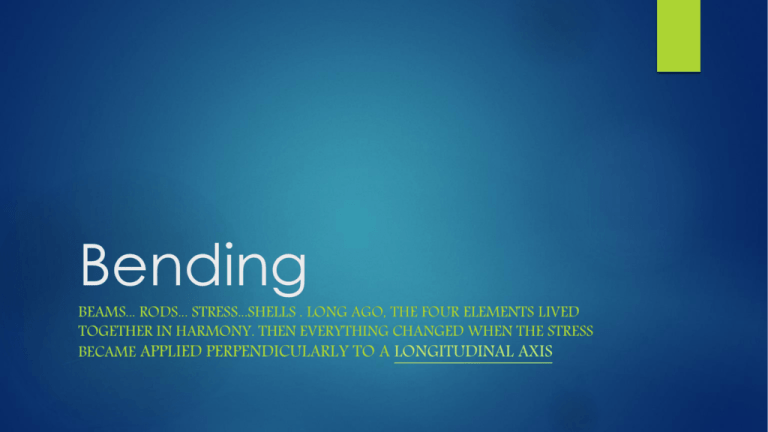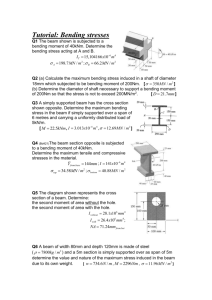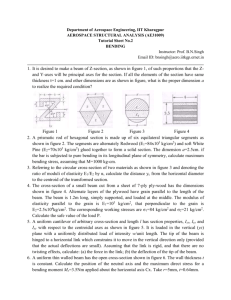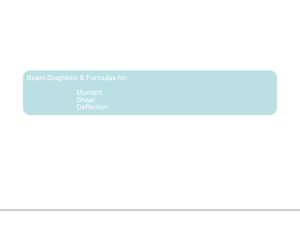Bending1
advertisement

Bending BEAMS... RODS... STRESS...SHELLS . LONG AGO, THE FOUR ELEMENTS LIVED TOGETHER IN HARMONY. THEN EVERYTHING CHANGED WHEN THE STRESS BECAME APPLIED PERPENDICULARLY TO A LONGITUDINAL AXIS Gottfried Wilhelm Leibniz Philosopher Mathematician Scientist Biology Geology Psychology Computer science Physicist Engineer Linguistician Librarian Lawyer Philologist Made important contributions to: 1646-1716 Mathematics Metaphysics Epistemology (the investigation of what distinguishes justified belief from opinion) Logic Philosophy Physics Geology Jurisprudence (philosophy of law) History Technology Ethics Probability Theory What do we care about? 3 big Topics: -Math -Science (physics in particular) -Engineering Then Let’s Next start onto wewith science… have math… engineering… Was Leibniz Discovered big believed in the calculus world greatly of (yeah, statics in applying I know, and dynamics theory I know,toNewton real world discovered applications calculus, right? Well not really. Disagreed “father Leibniz of applied actually with Descartes science” discovered and Newton calculuson at many the same subjects time as, and independently of Designed Newton) He many saw useful space,items time, and motion as relative, whereas Newton thought them to be Wind-driven propellers, water pumps, mining machines, hydraulic Many absolute of the notations Leibniz created are still used todaypresses, lamps, submarines, clocks, steam engine (with Papin)Einstein E.g He therecognized integral sign this and 200 using yearsd before for Denis derivatives Albert Contributed tofirst computer Was the found the energy to use ofintegrals ascience systemto tofind be mv the2area under a curve Documented the binary numeral system Discovered This led him theto product his Theory ruleof forMotion differentiation pertaining to kinetic and potential energy While studying the system, he imagined a machine that could represent binary He realized that the total energy in a system will be conserved numbers He actually envisioned the first computer Brushed upon the concept of feedback Academic Life His father was a professor of history When he died, Gottfried inherited his library First studied math when he was 17 Never formally learned physics Went to Law School Hermann von Helmholtz German physicist CONSERVATION OF ENERGY!!! He theorized a relationship between mechanics, heat, light, electricity, and magnetism Put them all into one category under a single force, or energy Went to school for medicine Never attended any math courses Was completely self-taught 1821-1894 The Art and Science of Bending Basics: Definition: The change in form of an object when a load is applied perpendicularly to a longitudinal axis of the object Example: The Types of Setups for Bending Simple Cantilever The Quasistatic Scenario Don’t worry, it just means that the amount of bending, and the forces, don’t change over time Euler-Bernoulli Theory of Bending Applies to simple bending only The theory was constructed using a combination of four different aspects of beam theory Kinematic Constitutive Describes how the direct stress and direct strain within the beam are related Force Resultant The motion of the deflection Help track important forces in the beam Equilibrium How the internal stresses of the beam balance out an external load The Equation Amount of deflection How much will it deflect in relation to the load placed on it? 4 dw The Applied Load EI dx4 = q(x) That’s how much Young’s Modulus Area Moment of Inertia The Components of that Equation Young’s Modulus Mechanical property of linear elastic solid materials Measures the force needed to stretch or compress a material sample Area Moment of Inertia Shows how an area’s points are distributed with respect to an arbitrary axis Bending Stress in a Beam Some Prior Knowledge Basis: It is assumed that plane sections in the beam will remain plane This means that no shear forces on a section are taken into account Therefore the theory does not deal with shear forces on the object Another Drawback Also relies on the fact that the yield stress of the object is greater than the maximum applied stress Yield stress is the amount of stress an object can take before it deforms plastically rather than elastically A material that deforms elastically returns to its original shape A material that deforms plastically will remain deformed permanently to some extent and is irreversible And Another… The material must follow Hooke’s law And Another…. The beam must be initially straight, and must have a cross section that is constant throughout. And Another…. The beam must have an axis of symmetry in the plane of bending And Another…. The beam must have a tendency to fail by bending rather than by crushing, wrinkling, or buckling So what’s it good for then? Well that’s a good question It does really well to explain simple cases of bending Provides a wonderful basis for the understanding of bending Gave other scientists a platform to work off of Engineers use it to analyze simple beams under an applied transverse load Timoshenko to the Rescue!! Stephen Timoshenko Russian Engineer Contributed immensely to the subjects of engineering mechanics, elasticity, and the strength of materials Improved the Euler-Bernoulli theory in 1921 How, you ask? Well, he accounted for the effect that shear forces had on a beam This made the theory much more accurate and applicable The New, Improved, Equation Kinematic assumptions Normals to the axis stay straight even after deformation Beam thickness is the same before and after deformation Shear Correction Factor Cross-sectional Area Shear Modulus (The ratio of the shear stress to the shear strain) Dynamic Bending Put that beam in motion, and watch it go, go, go It’s not that bad, actually Includes the mass and the second derivative of deflection with respect to time Oh…Never mind, I guess Includes the effect rotational inertia of the cross-section of the beam Also includes the shear stresses and accounts for shear deformations Applications of Bending Airplane wings “flutter” Basically are bending dynamically http://www.numeca.com/sites/numeca/files/wing.gif Many structures have materials under a longitudinal load, which bend By analyzing and understanding bending, these structures can be designed to be safer and better Airplane Wing Bending Bibliography "Beam Defelction." (n.d.): 396-419. Www.me.berkeley.edu. Web. 30 July 2015. <www.me.berkeley.edu/~lwlin/me128/BeamDeflection.pdf>. "Bending." Wikipedia. Wikimedia Foundation, 1 July 2015. Web. 30 July 2015. "Elastic Bending Theory." Elastic Bending Theory. N.p., 25 Jan. 2013. Web. 30 July 2015. "Euler-Bernoulli Beam Equation." Euler-Bernoulli Beam Equation. N.p., n.d. Web. 30 July 2015. "Gottfried Wilhelm Leibniz." Gottfried Wilhelm Leibniz. N.p., n.d. Web. 30 July 2015. "Hermann Von Helmholtz." Wikipedia. Wikimedia Foundation, n.d. Web. 30 July 2015. "Leibniz, Gottfried (1646-1716) -- from Eric Weisstein's World of Scientific Biography." Leibniz, Gottfried (1646-1716) -- from Eric Weisstein's World of Scientific Biography. N.p., n.d. Web. 30 July 2015. Smith, Kevin Randall. "Psyography: Biographies on Psychologists." Psyography: Biographies on Psychologists. N.p., n.d. Web. 30 July 2015.






